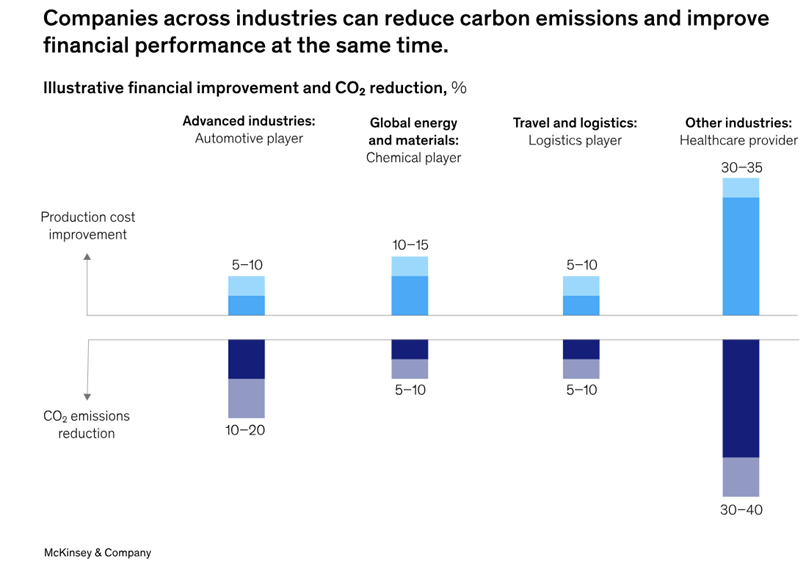In the last couple of years, an increasing number of companies have pledged to significantly reduce their carbon footprints. More than 6,000 companies have signed up through the Science Based Targets initiative to achieve an average 49% decrease in Scope 1 and 2 emissions, and a 28% cut in Scope 3 emissions by 2030. While these commitments are commendable, companies are now challenged to make the reductions a reality.
Decarbonization is the process of reducing or eliminating carbon dioxide (CO2) and other greenhouse gas (GHG) emissions from the atmosphere. To achieve decarbonization, companies must transition to renewable energy sources, improve energy efficiency, increase the use of electric vehicles and appliances, capture and store carbon emissions, and protect forests. Implementing these strategies can significantly reduce carbon footprint.
While there are costs associated with decarbonization, there are also tangible financial benefits for companies. Decarbonization can significantly reduce operating costs by improving energy efficiency, optimizing processes, transitioning to renewable energy, and mitigating risks. This approach can lead to lower energy bills, reduced waste, lower long-term operating costs, and enhanced reputation. For companies that prioritize sustainability, they are often viewed more favorably by consumers, investors, and employees. In addition, government incentives and competitive advantages can further drive decarbonization efforts and reduce costs. Finally, addressing climate-related risks can help protect a company’s financial stability and avoid costly penalties.
The transition to a low-carbon economy offers significant economic opportunities worldwide. Renewable energy, energy efficiency, electric vehicles (EVs), sustainable agriculture, carbon markets, green infrastructure, and the circular economy are all areas where decarbonization can create jobs, drive innovation, and promote economic growth. By investing in these areas, countries can reduce their dependence on fossil fuels, improve energy security, and mitigate climate change.

Decarbonization Case Studies
Here are a few case studies of companies that have successfully implemented decarbonization strategies.
Maersk, a global shipping giant, has been a leader of the decarbonization movement in the maritime industry. The company has set an ambitious goal to reduce its carbon emissions by 50% by 2030, compared to 2008 levels. Maersk has made significant progress in reducing its carbon emissions. The company’s efforts have set a benchmark for the industry, and have inspired other shipping companies to follow suit.
The company, by itself, has been responsible for approximately 0.1% of global carbon emissions, which makes its decarbonization targets particularly important. Maersk has completely bought in to decarbonization. This includes a commitment to cut emissions per shipping container by half and cut terminal emissions by 70% by 2030. This is along with accelerating its net zero target from 2050 to 2040. Maersk views decarbonization as an opportunity to achieve a long-term competitive advantage while doing the right thing, rather than a burden. Maersk decarbonization strategies include:
- Energy-efficient ships: Maersk has invested heavily in designing and building ships that are more fuel efficient. This includes innovations like hull design, propulsion systems, and engine optimization.
- Alternative fuels: The company has been investing in alternative fuels that have a lower carbon footprint. This includes methanol, biofuels, and synthetic fuels made from renewable sources.
- Carbon capture and storage: Maersk is investigating carbon capture and storage (CCS) technologies to capture and store carbon emissions from their ships.
- Digitalization: By leveraging digital technologies, Maersk has been able to optimize its operations, reduce fuel consumption, and improve efficiency.
General Motors (GM), a leading multinational automotive company, has set a goal to achieve carbon neutrality by 2035. The company’s decarbonization strategy focuses on a multi-pronged approach to reduce GHG emissions across its operations and products. Key elements of the decarbonization strategy includes:
- Electric vehicles (EVs): GM plans to expand its EV portfolio across different segments and price points, including passenger cars, SUVs, and trucks. In addition, the company is investing heavily in battery technology to improve range, reduce costs, and enhance charging speed. GM is also working to expand the availability of charging stations to support EV adoption.
- Hydrogen fuel cell electric vehicles (FCEVs): GM is exploring the potential of FCEVs as a complementary technology to EVs, particularly for heavy-duty applications. The company is also supporting the development of hydrogen fueling infrastructure.
- Sustainable manufacturing: GM is implementing energy-efficient practices in its manufacturing facilities to reduce GHG emissions. In addition, the company is increasing its use of renewable energy sources, such as solar and wind power, to power its operations. Finally, GM is committed to reducing waste and increasing recycling efforts.
- Carbon credits: GM purchases carbon credits from projects that reduce GHG emissions, such as reforestation, renewable energy projects, and methane capture. These credits allow the company to offset its own emissions and support sustainable initiatives.
- Circular economy: GM is exploring ways to incorporate circular economy principles into its operations, such as using recycled materials and designing products for reuse and recycling.
In recent years, a growing number of companies have pledged to significantly reduce their carbon footprint. Companies are investing in renewable energy, improving energy efficiency, adopting electric vehicles, and implementing carbon capture and storage technologies. These strategies not only help mitigate climate change but also offer financial benefits and enhance a company’s reputation. For an assessment of how your organization can establish or enhance its own decarbonization strategies, contact Canopy Edge.


